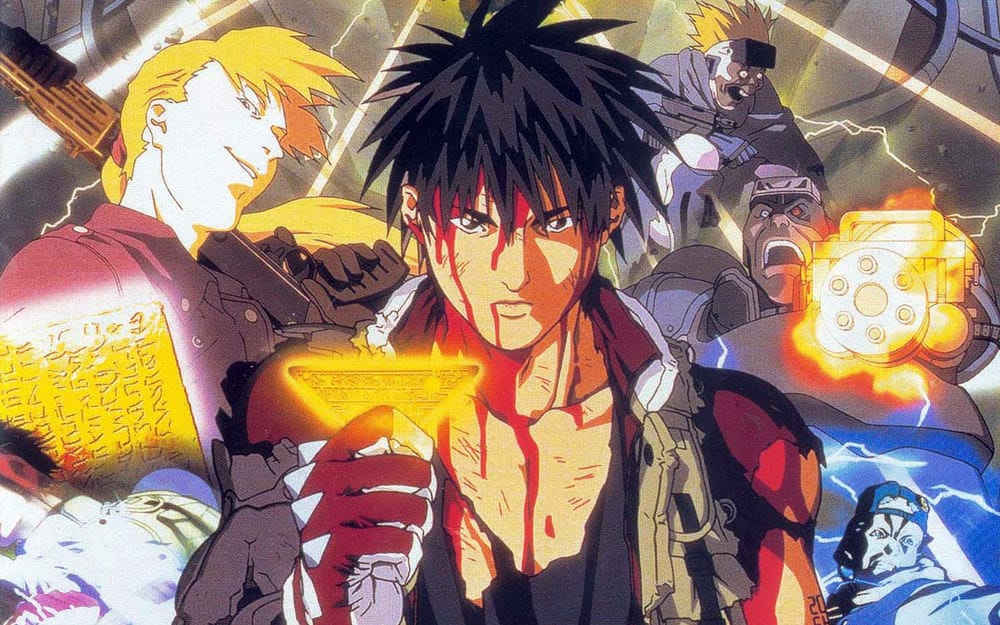
Sometimes, it’s tempting to say that anime is too highbrow for most people. On one hand, you’ve got the existentialism of Neon Genesis Evangelion and movies like Akira, where it seems like the big robot battles and psychic combat is overshadowed by lengthy discussions about the nature of existence and man’s place in the universe. Or you’ve got the political and psychological themes of Jin-Roh, or the heavy mix of Japanese culture and environmental themes in something like Princess Mononoke.
Not that that’s a bad thing, mind you. Quite the contrary, it’s one of the reasons why I love anime so much. Here in the West, we have this concept that animation is only for kids, provided there are enough musical numbers and heavy-handed moralizing, or mindless toilet humor. But when you watch something like Evangelion, and especially Hayao Miyazaki’s works, this philosophical complexity is often what makes it resonate so much. But there are those times when you just want to see big explosions and even bigger guns, without all of that unnecessary stuff like character and plot.
Enter Spriggan, the Commando of the anime world, with an Indiana Jones twist. Spriggan is truly at its best when it’s just a mindless action movie, complete with battle-suits, cyborgs with mini-guns for arms, and, of course, big explosions. It’s only when the plot deepens and some character depth is thrown into the film’s final quarter that it starts to lag.
Ominae Yu is like any other 17 year-old high school student. Well, except for the fact that he’s a highly trained operative (or “spriggan”) for a top secret organization called ARCAM. ARCAM was created to watch over a series of artifacts supposedly left on Earth by a highly advanced civilization ages ago. Spriggans are ARCAM’s frontline soldiers, greatly enhanced with battlesuits and cybernetic abilities, and charged with keeping these powerful relics from falling into the wrong hands.
Noah’s Ark just so happens to be one of these relics. As ARCAM furthers its studies of the artifact, their group is attacked by a splinter United States force led by the sinister Colonel MacDougall (a small kid with psychic powers and a huge God complex). But when MacDougall tries to use one of Yu’s classmates to assassinate him, Yu journeys to Turkey for some payback.
This is where the film is at its best. Early on, there’s an amazing sequence involving a chase through Turkey’s markets, where we get to see Yu’s powers in full swing. It’s also where you begin to see just how incredible Spriggan’s animation is, with detailed backgrounds of Istanbul’s buildings as a backdrop for the smooth, vibrant character animation. There’s a hefty amount of CGI throughout the movie, but its use is never glaringly obvious (due both to its quality and implementation).
Yu eventually makes it to ARCAM’s base camp, which, conveniently, soon falls under attack from U.S. forces led by Fat Man, Yu’s old commander (now sporting a nice little gatling gun for an arm) and Little Boy (who is quite fond of slicing and dicing ARCAM’s troops, literally). The action here is just insane, especially when Yu finally goes berserk on Fat Man, employing his fists, feet, a huge knife, and a snowmobile-mounted assault rifle. Ahhh… big, dumb, and completely gratuitous… the way action should be. Then MacDougall shows up, his psychic powers quickly making short work of ARCAM’s forces and especially Yu. Convinced his mission is a holy one, MacDougall breaks free from U.S. control and takes ARCAM’s chief scientist hostage, determined to unlock the Ark’s secrets.
Up until this point, Spriggan is coasting along quite merrily. However, I wonder if the filmmakers felt bad about throwing in so much action and so little depth. For whatever reason, the final confrontation between Yu and MacDougall, one that could go down in the annals of anime history as one of the great climactic battles, is hampered by some surprising twists that pop up concerning Yu’s past. In my mind, these were completely needless. I would’ve been fine with a lot of posturing and menacing gestures, followed by some serious smack-talking before the ass-kicking launched into full swing; however, it’s better than anything X had.
It’s not that the back-plot concerning Yu’s past is bad. It’s pretty much what you’d except from a movie like Spriggan, involving government projects, repressed memories of parents getting slaughtered, vengeance, double-crosses… you know, the usual. What’s bad is how convenient it feels. If a few details had been dropped earlier in the movie, perhaps the sudden revelation wouldn’t seem so misplaced. On the other hand, it could be that the filmmakers wanted to blow you away with intense visuals before dropping some plot your way, hoping to sneak it by. For my money, the intense visuals and detailed animation, not to mention big explosions, would’ve been enough.
Oh, and contrary to what you might read on the Internet Movie Database, it is not better than Akira, regardless of Katsuhiro Ötomo’s involvement.
